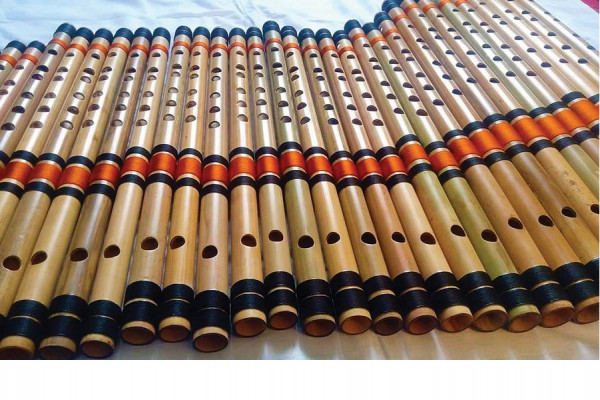The Essence of Music Through Bansuri

The sounds of the bansuri are Sa, Re, Ga, Ma, Dha, Ni and Sa and the scale of the bansuri for these sounds are C, C-sharp, D, D-sharp, E, F, F-sharp, G, G-sharp, A, A-sharp, B
If you have listened to traditional South Asian music, especially from Nepal, Bangladesh, India, Paskitan and Sri Lanka, you are quite familiar with the melodious sound of the bamboo flute or Bansuri. In Hinduism, the Bansuri is of great significance - it is played for Lord Krishna to spread the divinity of music during the Golden Age.
In the present era, there are many experts who exert themselves to proliferate the essence of Bansuri and blend it with modern music, to give it a traditional touch. On the other hand, there are makers of the Bansuri, who try to give it an A+ sound to the instrument. One such Bansuri maker is Resham Gurung. Resham's passion to recreate music with self-made bansuri, and his curiosity to do it better than the others have made him an expert to bring out the best tunes from the bamboo. He has been making bansuris since 2015. He started making the professional bansuri from the guidelines of the masterpiece bansuri that his brother had brought from India for his reference. According to him, an actual set of bansuri for 12 soundtrack consists of 24 pieces.
The process of making a bansuri begins with choosing a suitable bamboo for the sound. Bansuri can only be made by a specific kind of bamboo found in the forests of Meghlaya and Assam in India. For a proper finishing, the bamboo tree has to be at least 3-4 years of age. "If a raw bamboo has been cut from tree before the required time, then the bansuri will not produce the proper sound," says Resham. The bamboo is further cleaned and dried to clear the rust and damage while heating and refining them.
You may also like: Healing Music For Your Mental Health
After properly basking in the sun, the bamboos are examined upon which type of sound will be perfect for them. This is decided, depending on the length, its rawness and thickness it holds. The maker then scales up the dimensions of the length between the holes and diameter of the specific bansuri. The raw bamboo, when given a shape and completed with detailing, is then polished and designed. "A slight difference with only a 1mm cut can lead to an off tune of the sound of the bansuri," claimed Resham, pointing to the wasted bamboos and bansuris that were rejected due to the minimal differences.
"The flavor of the sound of the bansuri compliments the composition of music in both traditional and modern recordings," said Gurung, scrolling through his proven record of "Thamel Bazara", a popular Nepali song.
Going down memory lane, Resham Gurung started his proper business of making bansuri for his brother, Dhan Bahadur Gurung. Dhan is a "guru" of bansuri at Kalanidhi Indira Sangeet Mahavidhyalaya Nepal, Naad Sangeet Pathsala, GEMS School and various other music classes. Initially, Resham started by making flutes for the students for his brother classes. Now, he sells up to 20 -25 complete sets of his bansuri every year. Due to the complimentary sound that the flute provides to music, the demand of the instrument is rising beyond the borders as well. Interested visitors can also take tuitions with Dhan Bahadur Gurung and are motivated to embrace the tunes in their native bands at home.
